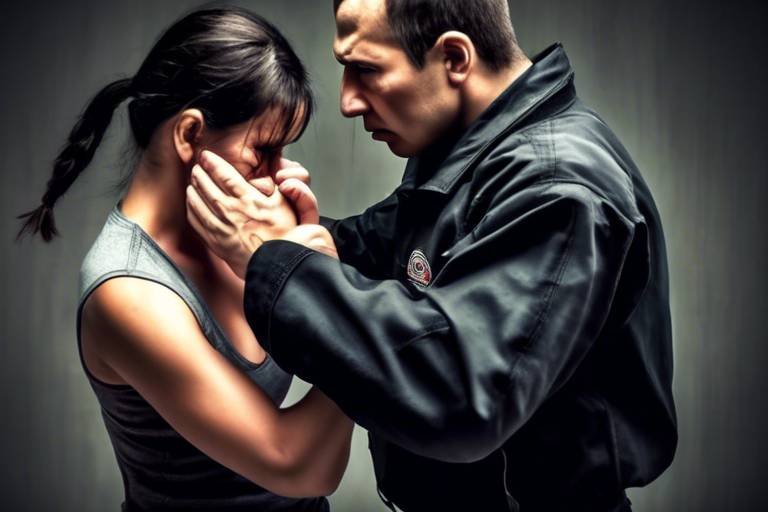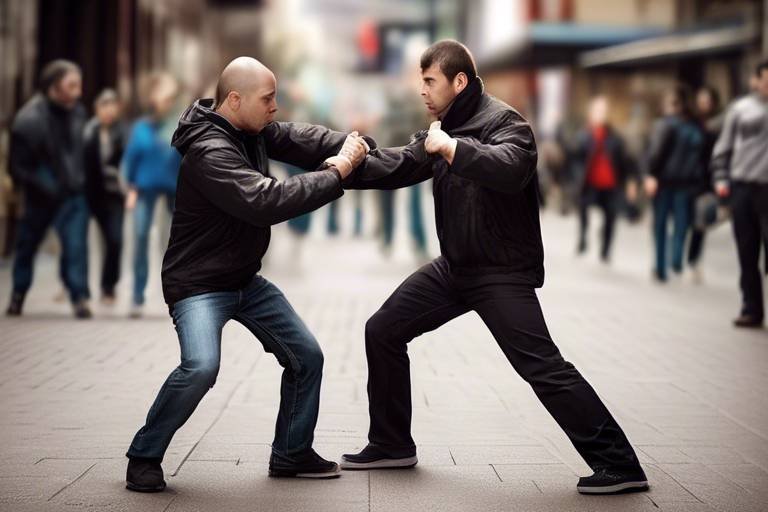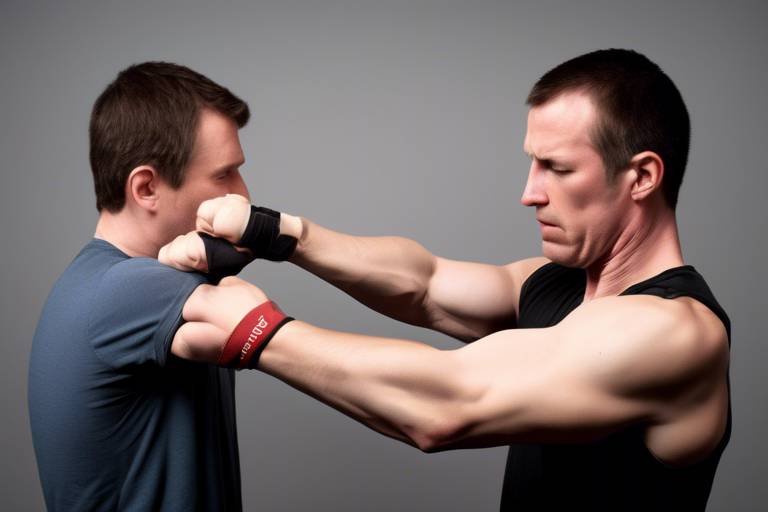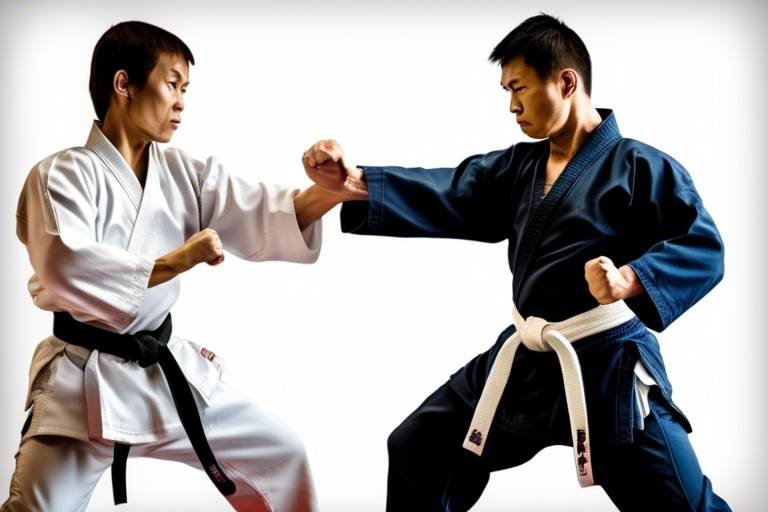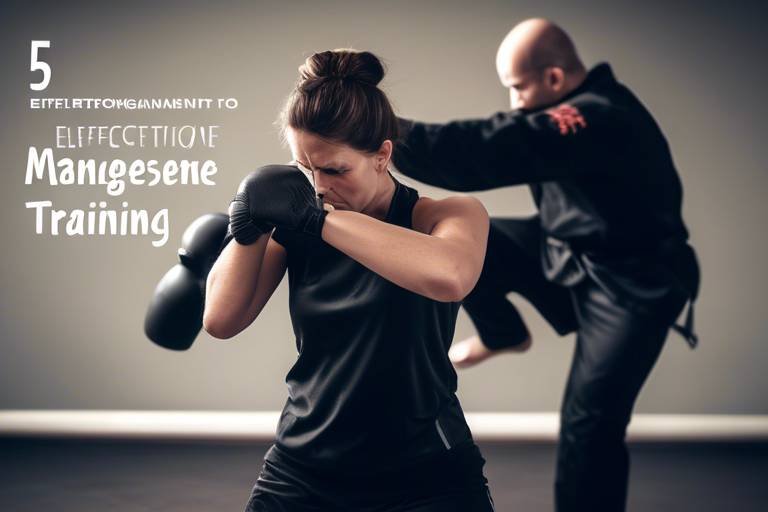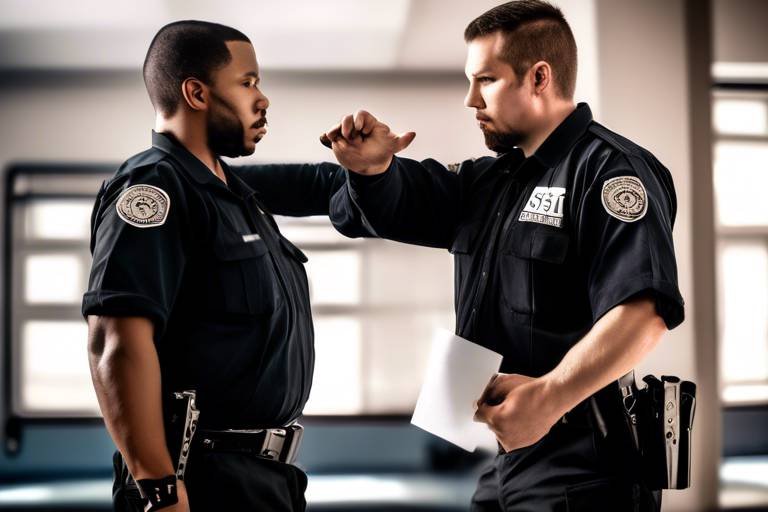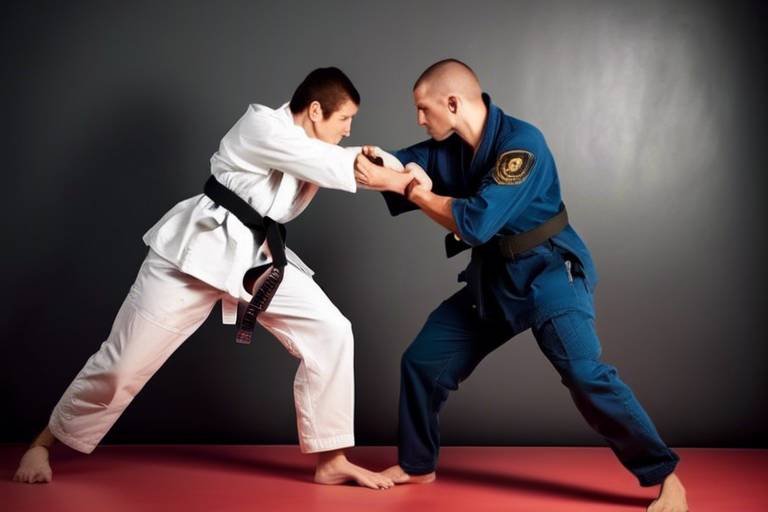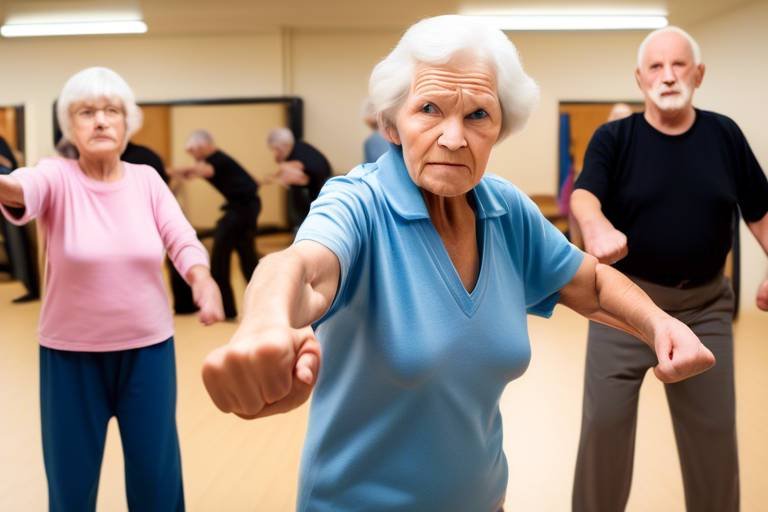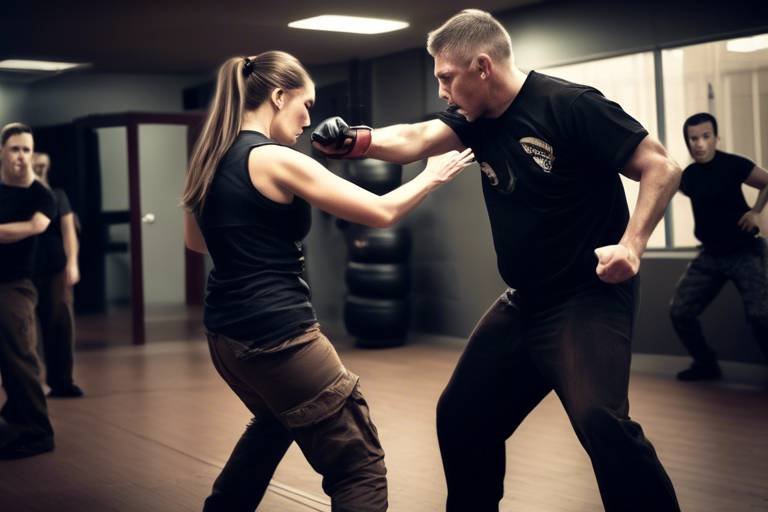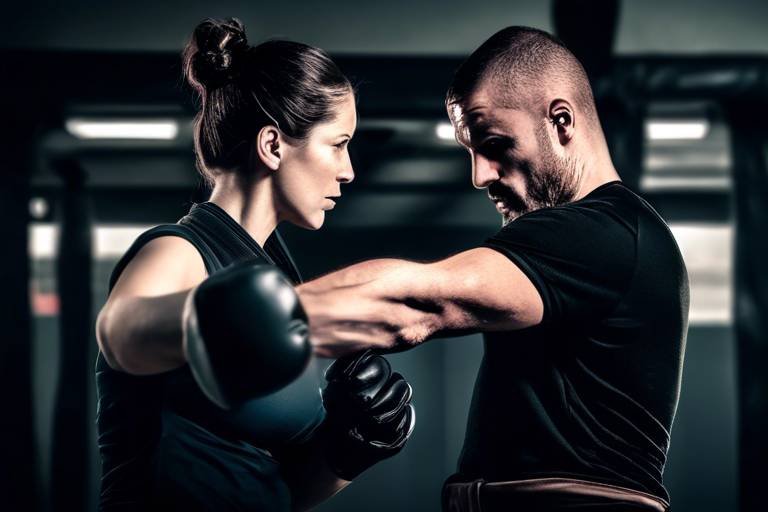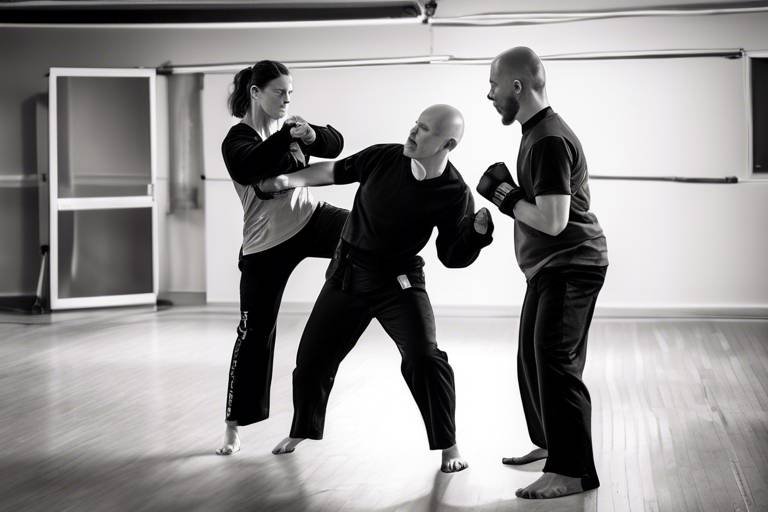How to Implement Self-Defense Techniques in Everyday Life?
In today's world, the importance of personal safety cannot be overstated. Self-defense is not just about physical techniques; it's about cultivating a mindset that prioritizes safety and awareness. Implementing self-defense techniques in your everyday life empowers you to navigate various situations with confidence and agility. Whether you're walking home at night, traveling alone, or simply going about your daily routine, knowing how to protect yourself can be a game-changer. So, how do you seamlessly integrate these techniques into your life? Let’s delve into practical ways to make self-defense a natural part of your daily existence.
Before diving into the practical aspects, it's crucial to grasp the fundamental concepts of self-defense. Self-defense is legally defined as the right to protect oneself from physical harm. However, it’s essential to differentiate between self-defense and aggression. Self-defense is about responding to a threat, while aggression often involves unnecessary force. Understanding this distinction not only keeps you within legal boundaries but also fosters a sense of responsibility. Moreover, being aware of your surroundings and potential threats is a vital component of self-defense. It’s not just about physical readiness; it’s about mental preparedness.
Situational awareness is your first line of defense. By training yourself to be more observant, you can identify potential threats before they escalate. This involves recognizing changes in your environment and the behavior of those around you. It's like being a detective in your own life, always on the lookout for clues that something might be amiss. For instance, if you notice someone following you or an area that feels unusually deserted, these are signs to stay alert. But how do you cultivate this awareness? Here are some tips:
- Always be aware of your surroundings; avoid distractions like your phone when walking.
- Trust your instincts; if something feels off, it probably is.
- Practice scanning your environment for exits or safe places.
Recognizing threats can be a lifesaver. It’s not about living in fear but rather about being prepared. Common signs of potential danger include:
- Unusual behavior in individuals, such as excessive fidgeting or looking around suspiciously.
- Groups of people loitering in a way that seems out of place.
- Sudden changes in your environment, like a sudden lack of people in a usually busy area.
Understanding body language is a powerful tool in assessing intentions. For example, if someone approaches you with a closed-off posture—arms crossed, avoiding eye contact—this may indicate discomfort or aggression. Conversely, an open posture usually suggests friendliness. Being able to read these cues can help you gauge whether a situation is safe or poses a threat. It’s like having a sixth sense that alerts you to potential danger.
Paying attention to environmental cues is equally critical. This includes being aware of escape routes, well-lit areas, and potential hazards. For instance, if you find yourself in a dimly lit alley, knowing where the nearest exit is can make all the difference. Your environment can either enhance your safety or put you at risk, so it’s essential to be proactive.
Creating personalized safety strategies tailored to your lifestyle can empower you to handle various situations with confidence. This could mean altering your daily route to work to avoid isolated areas or ensuring that your phone is always charged and easily accessible. You can also consider carrying personal safety devices, such as pepper spray or a whistle, which can be effective deterrents in dangerous situations. Remember, self-defense is not just about physical techniques; it’s about being prepared mentally and strategically.
Once you’ve established a foundation of awareness and strategy, it’s time to familiarize yourself with basic self-defense techniques. These moves can be easily practiced and applied in real-life situations for effective personal protection. Simple techniques like punches, kicks, and defensive maneuvers can be crucial in a threatening scenario. For instance, learning how to deliver a strong kick to an attacker’s knee can provide you with the time you need to escape. The key is practice—make these techniques second nature.
Incorporating self-defense practice into your routine can significantly improve your skills and build muscle memory. Just like any other skill, the more you practice, the better you become. Consider finding classes in your area, ranging from martial arts to specialized self-defense workshops. Training with partners can also simulate real-life situations, helping you refine your techniques and build confidence in your abilities.
Q: Do I need to be physically strong to learn self-defense?
A: Not at all! Self-defense techniques often rely on leverage and strategy rather than brute strength. With practice, anyone can learn to defend themselves effectively.
Q: How often should I practice self-defense techniques?
A: Regular practice is key. Aim for at least once a week to keep your skills sharp and your confidence high.
Q: Can self-defense training help with anxiety about personal safety?
A: Yes! Engaging in self-defense training can help you confront and manage fears related to personal safety, leading to greater overall confidence.

Understanding Self-Defense Basics
Self-defense is not just about throwing punches or executing fancy moves; it’s a comprehensive understanding of how to protect yourself in various situations. At its core, self-defense revolves around the idea of protecting oneself from harm, but it also encompasses a range of legal implications and ethical considerations. Knowing when and how to react can make a significant difference in your safety. It’s essential to recognize that self-defense is fundamentally different from aggression. While self-defense is a response to a threat, aggression often involves initiating violence without provocation. This distinction is crucial not only for personal safety but also for legal protection.
Awareness is another fundamental aspect of self-defense. Being aware of your surroundings can often prevent dangerous situations from escalating. Think of it like being in a movie theater: if you’re engrossed in the film, you might miss the subtle cues around you, like someone acting suspiciously. On the other hand, if you’re alert, you can quickly identify potential threats and take steps to avoid them. This proactive approach is the essence of self-defense.
Moreover, understanding the legal implications of self-defense is vital. Different jurisdictions have varying laws regarding what constitutes acceptable self-defense. For instance, in some places, you may only use reasonable force to defend yourself, while in others, the laws may be more lenient. Familiarizing yourself with these laws can help you navigate situations more effectively and avoid legal troubles. Here’s a quick overview of key legal concepts:
| Legal Concept | Description |
|---|---|
| Duty to Retreat | Some jurisdictions require individuals to retreat from a threat if it is safe to do so before using force. |
| Proportionality | The force used in self-defense must be proportional to the threat faced. |
| Imminent Threat | Self-defense can only be claimed if there is an immediate threat of harm. |
In summary, understanding self-defense basics involves grasping the concepts of awareness, legal implications, and the difference between self-defense and aggression. By integrating these principles into your daily life, you can enhance your personal safety and confidence. Remember, self-defense is as much about mental preparedness as it is about physical techniques.
- What should I do if I feel threatened? Trust your instincts. If you feel unsafe, remove yourself from the situation if possible.
- Is self-defense legal everywhere? Self-defense laws vary by location, so it's important to understand the laws in your area.
- Can self-defense training help with confidence? Absolutely! Training can empower you and help you feel more secure in your ability to handle threats.

Situational Awareness
Situational awareness is a crucial skill that can significantly enhance your personal safety. It involves being aware of your surroundings, understanding the dynamics of your environment, and recognizing potential threats before they escalate into dangerous situations. Think of it as having an internal radar that helps you navigate through life while keeping you safe. Just like a skilled driver who scans the road for hazards, you can train yourself to observe and interpret cues in your environment that may indicate danger.
One of the first steps in cultivating situational awareness is to develop a habit of actively observing your surroundings. This means not just looking, but truly seeing. Are there people nearby? How are they behaving? Is there anything unusual about the environment? By asking yourself these questions, you can start to build a mental map of your surroundings, which can be incredibly valuable in identifying potential threats.
Moreover, situational awareness isn't just about recognizing threats; it's also about understanding the context of your environment. For instance, a crowded area might feel safe because of the presence of many people, but if you notice someone acting suspiciously, that perception can quickly change. Similarly, a quiet street may seem dangerous at first glance, but if you are aware of the local community and its dynamics, you might feel more at ease. Thus, it's essential to be aware of both the people and the environment around you.
Identifying common signs of potential danger can help you stay alert and prepared to respond effectively. Some common indicators of a possible threat include:
- Inconsistent Behavior: Individuals who act out of the ordinary, such as someone pacing nervously or glancing around frequently, may be exhibiting signs of anxiety or agitation.
- Proximity: If someone is getting too close for comfort, it’s essential to trust your instincts. Personal space is a critical factor in assessing safety.
- Group Dynamics: A group of people who appear to be isolated from the rest of the crowd may indicate a potential issue, especially if they are engaging in aggressive behavior.
Understanding body language can provide crucial insights into others' intentions. For example, crossed arms or a tense posture may indicate defensiveness or aggression. Conversely, relaxed body language often suggests that a person is at ease. By honing your ability to read these signals, you can gauge whether a situation is safe or poses a threat. It’s like having a sixth sense—an instinct that helps you decipher unspoken cues in your environment.
Being aware of your surroundings also means recognizing environmental cues. This includes understanding the layout of a space, identifying escape routes, and noting potential hazards. For instance, if you’re in a public area, look for exits or safe zones where you can retreat if necessary. Similarly, be mindful of obstacles that could impede your movement, such as crowded areas or poorly lit spaces. The more familiar you are with your environment, the better equipped you will be to respond to unexpected situations.
In conclusion, developing situational awareness is not just about being alert; it’s about being proactive in ensuring your safety. By actively observing your surroundings, recognizing potential threats, and understanding the context of your environment, you can significantly reduce your risk of encountering dangerous situations. So, the next time you step outside, remember to engage your internal radar and stay aware of what’s happening around you!
Q: What is situational awareness?
A: Situational awareness is the ability to perceive and understand your environment and its dynamics, allowing you to recognize potential threats and respond accordingly.
Q: How can I improve my situational awareness?
A: You can improve your situational awareness by actively observing your surroundings, recognizing body language, and understanding environmental cues.
Q: Is situational awareness only important in dangerous situations?
A: No, situational awareness is beneficial in everyday life. It helps you navigate social interactions, avoid accidents, and make informed decisions.

Recognizing Threats
Recognizing potential threats is a crucial skill that can significantly enhance your personal safety. It's not just about knowing how to defend yourself during an attack; it's about being proactive and aware of your surroundings. Imagine walking through a park and noticing a group of individuals who seem overly aggressive or a person lingering too long in a secluded area. These are signs that should trigger your instincts to assess the situation further.
To effectively recognize threats, you need to develop a keen sense of observation. This involves not only watching people but also understanding their body language and the environmental cues around you. For instance, if someone is pacing back and forth, clenching their fists, or avoiding eye contact, these can be indicators of agitation or aggression. On the other hand, a relaxed posture and open gestures often suggest a non-threatening demeanor.
Moreover, being aware of your environment is equally important. Always look for escape routes and potential hazards. For example, when entering a new place, take a moment to scan the area for exits, well-lit paths, and other people. This awareness can make a significant difference in your ability to respond to an unexpected situation. The more you practice this kind of awareness, the more natural it becomes, almost like second nature.
In addition to body language and environmental cues, there are common signs of potential danger that you should be aware of, such as:
- Unusual behavior: Someone acting erratically or appearing overly nervous.
- Isolation: A person who is alone in a public area, especially if they seem out of place.
- Confrontational posture: Individuals standing too close or invading your personal space.
By honing your skills in recognizing these threats, you empower yourself to react swiftly and appropriately to various situations. Remember, the goal isn't just to identify threats but to prevent them from escalating into dangerous encounters. So, the next time you step out, take a moment to observe and assess your surroundings—you never know when that awareness might just keep you safe.
Q: How can I improve my situational awareness?
A: Start by practicing mindfulness in your daily activities. Pay attention to your surroundings, notice people's behaviors, and make it a habit to look for exit routes when you enter new spaces.
Q: Are there specific signs that indicate someone is a potential threat?
A: Yes, signs include aggressive body language, unusual behavior, and individuals who seem overly focused on you without any clear reason.
Q: What should I do if I feel threatened?
A: Trust your instincts. If you feel uncomfortable, try to leave the situation if possible. If you can't, seek help from others or call for assistance.

Body Language Indicators
Understanding body language is crucial for enhancing your situational awareness and recognizing potential threats. People often communicate their intentions through non-verbal cues, and being able to read these signals can help you gauge whether a situation is safe or if it requires caution. For instance, if someone approaches you with their hands in their pockets and a tense posture, it may indicate discomfort or hostility. On the other hand, open body language, such as uncrossed arms and a relaxed stance, generally suggests friendliness.
Here are some key body language indicators to watch for:
- Facial Expressions: The face can reveal a lot about a person's emotional state. A furrowed brow or clenched jaw might suggest anger or frustration, while a smile and relaxed features typically indicate calmness.
- Posture: How someone stands or sits can tell you about their confidence and intentions. A person who stands tall with shoulders back is often more self-assured, whereas someone who slouches may be insecure or hiding something.
- Eye Contact: Maintaining eye contact can show confidence and honesty, while avoiding it might suggest deceit or discomfort. However, too much staring can also be perceived as aggressive.
- Gestures: Rapid or erratic movements can indicate agitation or nervousness, while slow, deliberate gestures may convey calmness and control.
It's also important to consider the context in which these body language cues occur. For example, someone may have their arms crossed simply because they are cold, not necessarily because they are defensive. Thus, it’s essential to observe the overall situation and combine body language analysis with other environmental cues.
By honing your ability to read body language, you can better prepare yourself to respond to potential threats. This skill not only enhances your personal safety but also builds your confidence in navigating various social interactions. Remember, the more you practice observing these indicators, the more intuitive your responses will become, allowing you to stay one step ahead in any situation.
- What should I do if I notice threatening body language?
It's essential to trust your instincts. If you feel uncomfortable or perceive a threat, it's best to distance yourself from the situation and seek help if necessary. - Can body language be misinterpreted?
Yes, body language can sometimes be misleading. Cultural differences and personal habits can influence how gestures and postures are perceived, so always consider the context. - How can I improve my ability to read body language?
Practice makes perfect! Start by observing people in various settings and noting their body language. Over time, you'll become more adept at recognizing patterns and cues.

Environmental Cues
When it comes to personal safety, being aware of your surroundings is crucial. are the subtle signs and signals in your immediate area that can indicate whether a situation is safe or potentially dangerous. It's like being a detective in your own life—constantly scanning for clues that could help you avoid danger. For instance, consider the lighting in a parking lot; if it's dimly lit, it may raise red flags about your safety. Similarly, the behavior of people around you can be telling. Are they acting unusually? Are there groups of individuals loitering in a way that makes you feel uncomfortable? These are all important cues to note.
To enhance your situational awareness, you might want to adopt a habit of scanning your environment regularly. This doesn't mean you should walk around paranoid, but rather, you should develop a natural instinct for noticing things that seem out of place. For example, if you’re walking down the street, take a moment to observe the storefronts, the people passing by, and any exits or escape routes. Ask yourself questions like: Is there a way out if I need it? Are there any potential hazards nearby? This level of awareness can help you react quickly if a situation takes a turn for the worse.
Moreover, understanding environmental cues can also involve recognizing the layout of a space. For instance, in a crowded area, you might want to identify where the nearest exits are located. In a restaurant, knowing where the kitchen is can provide a quick escape route if needed. Here’s a quick breakdown of what to look for:
| Cue Type | What to Look For | Why It Matters |
|---|---|---|
| Lighting | Bright vs. dimly lit areas | Well-lit areas are generally safer and deter criminal activity. |
| People | Groups vs. solitary individuals | Groups may indicate a potential threat; solitary individuals may be safer. |
| Exit Routes | Identifying exits in public spaces | Knowing your escape routes can save valuable time in emergencies. |
| Unusual Behavior | People acting out of character | Recognizing odd behavior can alert you to potential danger. |
In essence, being attuned to your environment is not just about being cautious; it’s about empowering yourself with the knowledge that can help you make informed decisions. By honing in on these environmental cues, you can significantly enhance your personal safety and reduce the risk of finding yourself in a precarious situation.
- What are environmental cues? Environmental cues are signs in your surroundings that can indicate safety or danger, such as lighting, people’s behavior, and layout of spaces.
- How can I improve my situational awareness? Regularly scan your environment, identify exits, and pay attention to unusual behaviors around you.
- Why is it important to recognize environmental cues? Recognizing these cues can help you avoid dangerous situations and react effectively if something unexpected occurs.

Developing Personal Safety Strategies
When it comes to personal safety, having a well-thought-out strategy can be your best ally. Just like a knight prepares for battle, you too should arm yourself with a plan tailored to your daily life. Think about your routines—where do you go, what times do you travel, and who do you interact with? By analyzing these aspects, you can create a personalized safety strategy that empowers you to navigate your surroundings with confidence.
One of the first steps in developing your strategy is to identify your vulnerabilities. Are there areas in your neighborhood that make you feel uneasy? Perhaps you often find yourself in crowded places where it’s hard to keep track of your belongings. Recognizing these vulnerabilities allows you to be proactive rather than reactive. For example, if you’re uncomfortable walking alone at night, consider adjusting your schedule or finding a buddy system with friends.
Next, it’s essential to establish a routine that prioritizes your safety. This can include simple yet effective measures such as:
- Always informing someone of your whereabouts, especially if you’re going to a new place.
- Carrying a personal safety device, like a whistle or pepper spray, that you can easily access.
- Keeping your phone charged and easily accessible for emergencies.
Moreover, practice makes perfect! Regularly rehearse your safety strategies, whether it’s how to escape a situation or how to react if approached by a stranger. Consider scheduling a monthly “safety day” where you review your strategies and practice them with friends or family. This not only keeps your skills sharp but also helps you feel more confident in your abilities.
Another critical aspect of your personal safety strategy is to stay informed. Knowledge is power, after all. Keep up with local news and community alerts so you’re aware of any potential threats in your area. Additionally, familiarize yourself with local resources, such as nearby police stations or community safety programs. This knowledge can provide peace of mind and quick access to help if needed.
Incorporating these strategies into your daily life can significantly reduce the likelihood of dangerous situations. Remember, it’s not about living in fear but rather about being prepared and aware. By developing a personal safety strategy, you’re taking control of your environment and ensuring that you can handle whatever comes your way.
- What should I do if I feel threatened? Trust your instincts. If you feel unsafe, try to remove yourself from the situation as quickly as possible and seek help.
- Are there specific self-defense techniques I should focus on? Yes, basic striking techniques and defensive maneuvers are essential. Focus on moves that you can easily remember and execute under pressure.
- How often should I practice my self-defense skills? Regular practice is vital. Aim to practice at least once a week to build muscle memory and confidence.
- Can self-defense classes help me develop a safety strategy? Absolutely! Self-defense classes often cover situational awareness and personal safety strategies, providing valuable insights.

Basic Self-Defense Techniques
When it comes to personal safety, having a few in your arsenal can make all the difference. These moves are not just for martial artists; they are practical skills that anyone can learn and apply in real-life situations. Imagine walking down the street and suddenly feeling threatened—knowing how to react can empower you and potentially save you from harm. In this section, we will explore some fundamental techniques that are easy to learn and can be practiced regularly.
One of the most effective ways to defend yourself is through striking techniques. These include punches, kicks, and elbow strikes that can help you create distance from an aggressor. For instance, a well-placed punch to the nose can disorient an attacker long enough for you to escape. Similarly, a swift kick to the knee can incapacitate someone who is trying to grab you. The key is to focus on your target and deliver your strikes with confidence and precision.
But striking isn't the only method of self-defense. Defensive maneuvers are equally important. These techniques involve evading or blocking an attacker’s moves to protect yourself. For example, if someone throws a punch, stepping to the side and using your forearm to block can redirect their energy without causing you harm. This approach not only keeps you safe but also gives you the opportunity to counterattack if necessary.
To help you better understand some of these techniques, here’s a simple table that outlines a few basic striking and defensive maneuvers:
| Technique | Description | Purpose |
|---|---|---|
| Punch | A quick strike using a closed fist. | To disorient the attacker. |
| Kick | A powerful strike using the leg. | To create distance or incapacitate. |
| Block | Using your arms to deflect an attack. | To protect yourself from harm. |
| Evade | Moving out of the way of an attack. | To avoid confrontation altogether. |
Regular practice of these techniques is essential. Just like learning to ride a bike, the more you practice, the more natural it becomes. You might consider finding a local self-defense class or martial arts studio where you can learn these techniques under the guidance of a trained instructor. Not only will you gain valuable skills, but you’ll also build muscle memory, which is crucial during high-stress situations.
In addition to classes, practicing with a partner can greatly enhance your learning experience. You can simulate real-life scenarios, allowing you to refine your techniques and build confidence in your abilities. Think of it like a dance; the more you practice the steps together, the more fluid and instinctive your movements become.
Ultimately, understanding and mastering these basic self-defense techniques can significantly increase your confidence and sense of security. Whether you find yourself in a threatening situation or simply want to feel more empowered in your everyday life, these skills can provide you with the tools you need to protect yourself. Remember, self-defense is not just about physical techniques; it’s also about mental preparedness and awareness. So, get out there, practice, and embrace the confidence that comes with knowing you can defend yourself!
Q: Do I need to be physically strong to defend myself?
A: Not necessarily! Self-defense techniques focus on using your body effectively, and many moves rely on speed and technique rather than brute strength.
Q: How often should I practice self-defense techniques?
A: Regular practice is key. Aim for at least once a week to maintain your skills and build muscle memory.
Q: Can self-defense training help with confidence?
A: Absolutely! Engaging in self-defense training can significantly boost your confidence and empower you to handle various situations more effectively.

Striking Techniques
When it comes to self-defense, mastering is essential. These techniques not only provide you with the ability to defend yourself but also instill a sense of confidence that can be invaluable in threatening situations. Striking techniques primarily include punches, kicks, and other forms of physical contact that can incapacitate an attacker long enough for you to escape. Think of it like having a powerful tool in your toolbox; it’s not just about knowing how to use it, but also when to utilize it effectively.
One of the most fundamental striking techniques is the jab. This quick punch can create distance between you and an assailant. It’s often the first move taught in martial arts classes because it’s straightforward and effective. Imagine it as the opening line in a conversation; it sets the tone for what follows. The jab can distract or deter an attacker, allowing you time to plan your next move.
Next, we have the cross, which is a powerful straight punch delivered with your dominant hand. This technique requires proper stance and weight transfer to maximize impact. Think of your body as a coiled spring; when you release that energy through your punch, it can deliver significant force. Practicing the cross not only improves your striking power but also enhances your coordination and balance.
In addition to punches, kicks are another vital component of striking techniques. The front kick, for instance, is a versatile move that can target an opponent's abdomen or groin, providing a strong deterrent. It’s like a swift kick to the door when you want to make an entrance; it demands attention and can create an opportunity for escape. Kicking techniques require flexibility and strength, making them excellent for overall fitness as well.
Another effective kick is the roundhouse kick. This technique involves swinging your leg in a circular motion to strike an opponent with the shin or foot. It’s a dynamic move that can catch an attacker off guard. Picture a windmill; the rotation is powerful and can generate significant force. Regular practice of the roundhouse kick can improve your agility and timing, which are crucial in self-defense scenarios.
To effectively integrate these striking techniques into your self-defense arsenal, it’s vital to practice regularly. Consider enrolling in a self-defense class or martial arts training that emphasizes striking. Not only will you learn the mechanics of each technique, but you’ll also gain valuable insights into timing and distance management. Remember, the goal is not just to strike hard but to strike smart.
As you progress in your training, it’s essential to simulate real-life scenarios. Practicing with a partner can help you understand how to apply these techniques under pressure. Just like a musician rehearses for a concert, your practice sessions should be focused and intentional. The more you practice, the more natural these movements will become, allowing you to respond instinctively when it matters most.
- What are the best striking techniques for beginners?
For beginners, basic punches like the jab and cross, along with front kicks, are excellent starting points. They are easy to learn and can be very effective in a self-defense situation.
- How often should I practice striking techniques?
Consistency is key. Aim to practice at least 2-3 times a week, incorporating both solo drills and partner work to build muscle memory and confidence.
- Can striking techniques be learned online?
Yes! There are many online courses and video tutorials available that can teach you the fundamentals of striking techniques. However, hands-on practice with a qualified instructor is highly recommended for safety and effectiveness.

Defensive Maneuvers
When it comes to self-defense, understanding can be your first line of protection. These techniques are designed not just to protect you but to help you evade an attack effectively. Imagine being in a situation where someone is coming at you aggressively. Instead of panicking, having a few defensive moves in your arsenal can make all the difference. It's like having a safety net; you might not need it often, but when you do, it’s invaluable.
Defensive maneuvers can range from simple evasive actions to more complex techniques that involve redirecting an attacker's energy. For instance, one of the most basic yet effective maneuvers is the side step. By shifting your weight and moving to the side, you can avoid a direct attack while positioning yourself for a counter-move. Think of it as dancing; you need to be light on your feet and ready to move in any direction.
Another essential defensive technique is the block. This involves using your arms to shield yourself from strikes. However, it's crucial to remember that blocking isn’t just about raising your arms; it’s about using your body’s natural movements to absorb the impact. Proper technique can minimize injury and keep you in a position to respond. Consider it like a shield in a video game; it’s not just there to absorb damage, but also to give you a moment to strategize your next move.
To further enhance your understanding, let’s look at some common defensive maneuvers:
| Technique | Description | When to Use |
|---|---|---|
| Side Step | Quickly moving to the side to avoid an attack. | When an attacker lunges or reaches towards you. |
| Block | Using your arms to shield yourself from blows. | When facing a direct strike. |
| Duck | Lowering your body to evade high strikes. | When an attacker swings at your head. |
| Redirect | Using an attacker's momentum against them. | When close enough to apply leverage. |
Practicing these maneuvers regularly can help you react instinctively in a threatening situation. Just like any skill, the more you practice, the better you become. It’s not just about the physical movements, but also about building the mental confidence to know that you can handle yourself. So, whether you’re in a self-defense class or practicing at home, take the time to master these techniques. They could be the difference between safety and danger.
- What are defensive maneuvers? Defensive maneuvers are techniques used to protect oneself from an attack, including blocking, evading, and redirecting an attacker's energy.
- Can I learn defensive maneuvers on my own? While self-study is possible, attending a self-defense class is highly recommended for proper guidance and practice.
- How often should I practice these techniques? Regular practice is essential. Aim for at least a few sessions each month to maintain your skills.
- Are defensive maneuvers effective in real-life situations? Yes, when practiced consistently, they can significantly enhance your ability to protect yourself in various scenarios.

Practicing Self-Defense Regularly
When it comes to self-defense, just like any other skill, practice makes perfect. Integrating self-defense practice into your routine not only sharpens your skills but also builds the muscle memory essential for effective reaction in high-pressure situations. Imagine trying to ride a bike without ever practicing; it would be a daunting task, right? Similarly, the more you practice self-defense techniques, the more instinctive they become. Regular practice can transform your responses from hesitation to immediate action, enhancing your ability to protect yourself when it matters most.
One of the best ways to ensure you’re consistently practicing is to schedule regular training sessions. Whether it’s attending a weekly class or setting aside time at home to practice techniques, consistency is key. You might want to create a training calendar that outlines your practice sessions, making it easier to stay committed. Here’s a simple example:
| Day | Practice Focus | Duration |
|---|---|---|
| Monday | Striking Techniques | 30 minutes |
| Wednesday | Defensive Maneuvers | 30 minutes |
| Friday | Combination Drills | 45 minutes |
In addition to structured classes, practicing with a partner can significantly enhance your training experience. Not only does it provide a chance to test your skills against a real opponent, but it also allows you to receive immediate feedback on your techniques. This dynamic interaction can mimic the unpredictability of real-life situations, making your practice more relevant and effective. Plus, training with a friend can make the experience more enjoyable and less intimidating.
Moreover, don't underestimate the power of solo practice. You can work on your footwork, shadow boxing, or even visualization techniques. Picture yourself successfully defending against an attacker while executing your moves flawlessly. This mental rehearsal can be just as powerful as physical practice. The key is to find a balance between individual training and partner work, ensuring you cover all aspects of self-defense.
Finally, remember that practicing self-defense isn’t just about physical techniques; it's also about cultivating a mindset of awareness and confidence. As you practice, you’ll find that your confidence grows, allowing you to approach potentially dangerous situations with a calm and collected demeanor. This mental fortitude can be just as crucial as any physical skill you acquire.
- How often should I practice self-defense? It’s recommended to practice at least 2-3 times a week to maintain and improve your skills.
- Can I practice self-defense at home? Absolutely! There are many techniques you can practice alone, such as footwork, shadow boxing, and drills.
- What if I don't have a partner to train with? You can still practice solo techniques and consider joining a local class to meet training partners.

Finding Classes
When it comes to enhancing your self-defense skills, finding the right class can be as crucial as the techniques you learn. With a plethora of options available, it’s essential to consider what suits your personal needs and goals. Are you looking for a martial arts class, a self-defense workshop, or perhaps a more specialized program? Each type of class offers unique benefits, and understanding these can help you make an informed decision.
First, think about your goals. Are you aiming to improve your physical fitness, learn practical self-defense techniques, or gain confidence in handling confrontational situations? Once you have a clear understanding of your objectives, you can start searching for classes that align with them. Many local gyms, community centers, and martial arts studios offer self-defense courses tailored to various skill levels, from beginners to advanced practitioners.
Another important aspect is the instructor's qualifications. A good instructor should not only be skilled in self-defense but also possess the ability to teach effectively. Look for instructors who have a background in martial arts, law enforcement, or personal safety training. You might want to check reviews or ask for recommendations from friends or family who have taken similar classes. This can provide insight into the instructor's teaching style and effectiveness.
Additionally, consider the class structure and environment. Some people thrive in a competitive atmosphere, while others prefer a more relaxed setting. Many studios offer trial classes, allowing you to experience the environment before committing. This is a fantastic way to gauge whether the class aligns with your learning style and comfort level.
Here are some popular types of self-defense classes you might encounter:
- Martial Arts Classes: These can include disciplines like Karate, Krav Maga, and Brazilian Jiu-Jitsu, all of which teach effective self-defense techniques.
- Women's Self-Defense Workshops: Tailored specifically for women, these workshops often focus on situational awareness and techniques to escape potential threats.
- Online Courses: If you prefer learning at your own pace, many platforms offer online self-defense courses that cover techniques and safety strategies.
In summary, finding the right self-defense class is a journey that requires research and consideration. By identifying your goals, evaluating instructors, and experiencing different environments, you can find a class that not only teaches you valuable skills but also empowers you to feel safe and confident in your daily life.
Q: How do I know if a self-defense class is right for me?
A: Assess your personal goals, comfort level, and the instructor’s qualifications. Attend trial classes to find the right fit.
Q: Are self-defense classes safe?
A: Yes, reputable self-defense classes prioritize safety and teach techniques in a controlled environment. Always communicate with your instructor about any concerns.
Q: Can I practice self-defense techniques at home?
A: Absolutely! Many techniques can be practiced solo, but it’s beneficial to train with a partner when possible to simulate real-life scenarios.

Training with Partners
Training with partners is one of the most effective ways to enhance your self-defense skills. Imagine this: you can learn all the techniques in the world, but without the opportunity to practice them in a realistic setting, those skills can easily fade away like a distant memory. Practicing with a partner not only makes your training sessions more dynamic and engaging, but it also simulates real-life scenarios where you might need to use your self-defense techniques. This dynamic interaction helps you understand timing, distance, and the unpredictability of an actual confrontation.
When you train with a partner, you can mimic various situations that you may encounter, which is crucial for developing your instinctive reactions. For instance, one of you can act as the attacker while the other practices defensive moves, allowing you to experience the pressure of an incoming attack. This can be both exhilarating and enlightening, as it reveals how well you can execute your techniques under stress. Moreover, it fosters a spirit of cooperation, where both partners are invested in each other's growth and safety.
Here are some benefits of training with a partner:
- Realistic Practice: You can practice techniques in a controlled yet realistic environment, which helps in understanding the nuances of timing and distance.
- Feedback: A partner can provide immediate feedback on your technique, helping you refine your skills and correct mistakes in real-time.
- Increased Motivation: Training with someone else can boost your motivation. You’re less likely to skip practice when you know someone is counting on you.
- Variety: Working with different partners exposes you to various styles and approaches, enhancing your adaptability and overall skill set.
Additionally, training with partners allows you to practice defensive maneuvers, such as escaping holds or countering attacks, in a safe environment. This not only builds muscle memory but also helps to reduce anxiety when faced with a real-life situation. Just like a dance, where each partner must be in sync, self-defense training requires coordination and communication. You learn to read your partner's movements and react accordingly, honing your instincts and reflexes.
In conclusion, incorporating partner training into your self-defense routine is not just beneficial; it's essential. It transforms your practice from theoretical knowledge into practical application, making you more prepared for any situation that may arise. So grab a friend, join a class, or find a training buddy, and start putting those techniques into action!
1. How often should I train with a partner?
It’s recommended to train with a partner at least once a week to maintain and improve your skills. Consistency is key!
2. What should I look for in a training partner?
Look for someone who is committed, shares similar goals, and is willing to provide constructive feedback. A supportive partner can greatly enhance your learning experience.
3. Can I train self-defense alone?
While solo training can be beneficial for practicing techniques and conditioning, working with a partner is crucial for developing timing and real-world application.
4. Are there specific drills I should do with a partner?
Yes! Drills like sparring, practicing escape techniques, and scenario-based training can be very effective. Be sure to vary your drills to keep things fresh and engaging.

Building Confidence Through Self-Defense
Engaging in self-defense training is not just about learning how to fight; it's about cultivating a sense of empowerment and confidence that extends far beyond the dojo or training mat. When you invest time in understanding self-defense techniques, you're not merely preparing for potential threats; you're also building a robust foundation of self-assurance that can positively influence various aspects of your life. Have you ever felt that rush of adrenaline when you master a new technique? That feeling is not just a fleeting moment; it's a testament to your growing confidence.
One of the most significant benefits of self-defense training is the way it helps individuals confront and manage their fears related to personal safety. Many people live with an underlying anxiety about their vulnerability in everyday situations. By actively participating in self-defense classes, you learn to recognize these fears and, more importantly, how to overcome them. It's like facing a monster under your bed; once you confront it, you realize it wasn't as terrifying as you imagined. As you practice and improve, you begin to feel a shift in your mindset—moving from a place of fear to one of empowerment.
Moreover, the physical aspect of self-defense training plays a crucial role in boosting self-esteem. As you develop new skills, your body becomes stronger and more agile, which naturally enhances your self-image. The sense of accomplishment that comes from mastering a challenging move or successfully defending against a simulated attack can be exhilarating. It’s akin to climbing a mountain; each step you take builds your strength and resolve, making the summit feel all the more rewarding. The more you practice, the more your confidence grows, creating a positive feedback loop that reinforces your belief in your abilities.
Furthermore, self-defense training fosters a sense of community and support. When you train with others, you share experiences, challenges, and triumphs. This camaraderie can significantly enhance your confidence, as you realize that you’re not alone in your journey. It’s like being part of a team; everyone is working towards a common goal, cheering each other on, and celebrating victories together. This supportive environment not only makes training more enjoyable but also helps you feel more secure in your skills, knowing you have a network of allies behind you.
In conclusion, building confidence through self-defense is a multifaceted process that involves confronting fears, enhancing physical abilities, and fostering community support. As you embark on this journey, remember that every small step counts. Whether it's mastering a new technique or simply showing up to class, each effort contributes to your overall confidence. So, why not take that leap? Embrace the challenge of self-defense training and watch as your confidence blossoms in ways you never imagined!
- How long does it take to become proficient in self-defense? The time it takes varies by individual, but consistent practice over several months can lead to noticeable improvements.
- Do I need to be physically fit to start self-defense training? Not at all! Self-defense classes cater to all fitness levels, and training can help you improve your fitness over time.
- Is self-defense training suitable for all ages? Yes, self-defense training can be adapted for all age groups, making it accessible for everyone from children to seniors.

Overcoming Fear
Fear is a natural response, especially when it comes to personal safety. It's that instinctive feeling that makes your heart race and your palms sweat when you sense danger. However, while fear can be protective, it can also be paralyzing. The good news is that self-defense training can help you confront and manage these fears, transforming anxiety into confidence. Think of it like learning to ride a bike; at first, the thought of falling off can be daunting, but with practice, you gain balance and control.
One of the first steps in overcoming fear is to acknowledge it. Ignoring your feelings can lead to greater anxiety down the line. Instead, recognize that fear is a common emotion shared by many, especially when facing new challenges. Self-defense classes create a safe environment where you can express these fears and learn to navigate them. This supportive atmosphere allows individuals to share their experiences and realize they are not alone in their feelings.
Another effective strategy is to expose yourself gradually to situations that trigger your fear. This doesn’t mean putting yourself in harm's way, but rather practicing scenarios in a controlled setting. For instance, during training, you might simulate a confrontation with an instructor or partner. This practice can desensitize you to the fear of an actual attack. Over time, as you become more familiar with these situations, your fear will diminish, and you'll feel more equipped to handle them.
Moreover, understanding the psychology behind fear can be incredibly empowering. Fear often stems from the unknown; by educating yourself about potential threats and effective responses, you can demystify the situation. For example, knowing how to react when approached by a stranger can alleviate the fear of the unknown. In self-defense classes, you not only learn techniques but also the rationale behind them. This knowledge can serve as a mental toolkit, helping you feel more prepared and less anxious.
Lastly, remember that building a support system is crucial. Engage with fellow trainees or friends who share your interest in self-defense. Discussing your fears openly can foster a sense of community and encouragement. You can also participate in group training sessions, which can make the learning process more enjoyable and less intimidating. As you bond with others over shared experiences, you'll find that your fears diminish as your confidence grows.
In conclusion, overcoming fear is a journey that requires patience and practice. With the right mindset and support, self-defense training can transform fear into a powerful ally, empowering you to take control of your safety and well-being.
- What if I have no prior experience in self-defense?
Don’t worry! Many self-defense classes cater to beginners and emphasize foundational skills. - How long does it take to become proficient in self-defense?
Proficiency varies by individual, but regular practice can lead to noticeable improvements in a few months. - Is self-defense training suitable for everyone?
Yes! Self-defense training can benefit individuals of all ages and fitness levels. - Can self-defense techniques be used in non-violent situations?
Absolutely! Many techniques focus on de-escalation and avoidance, which can be useful in various scenarios.

Empowerment and Self-Esteem
Engaging in self-defense training is not just about learning how to throw a punch or evade an attack; it’s about cultivating a profound sense of empowerment and boosting your self-esteem. Imagine walking down the street, feeling a surge of confidence because you know you have the skills to protect yourself. This transformation is one of the most significant benefits of self-defense training. It’s akin to discovering a hidden superpower within you, allowing you to navigate the world with a renewed sense of security and assertiveness.
When individuals commit to learning self-defense techniques, they often find that their overall confidence levels rise. This newfound confidence can permeate various aspects of life, from personal relationships to professional endeavors. As you practice and refine your skills, you begin to see yourself not just as a victim but as someone who can take charge of their own safety. This shift in mindset is crucial; it’s like flipping a switch that illuminates your potential and capabilities.
Moreover, self-defense training fosters a sense of community and support among participants. Engaging in classes or group sessions allows individuals to share their experiences and challenges, creating a network of encouragement. This camaraderie reinforces the idea that you are not alone in your journey toward empowerment. It’s a collective effort where everyone uplifts one another, enhancing each person’s self-esteem in the process.
As you progress in your training, you may notice several key changes in your self-perception:
- Increased Self-Awareness: Understanding your strengths and weaknesses helps you set realistic goals.
- Resilience: Overcoming challenges in training builds mental toughness.
- Assertiveness: Learning to stand up for yourself translates into various life situations.
Ultimately, the journey of self-defense training is about more than just physical skills; it’s a pathway to becoming a more confident and empowered version of yourself. With each class, each practice session, you are not only learning how to defend yourself but also reinforcing the idea that you are capable, strong, and worthy of respect. This transformation is a powerful testament to the positive impact that self-defense can have on your life.
Q: Can anyone learn self-defense?
A: Absolutely! Self-defense techniques can be adapted for individuals of all ages and fitness levels.
Q: How long does it take to become proficient in self-defense?
A: Proficiency varies by individual, but consistent practice and training can lead to noticeable improvements within a few months.
Q: Do I need to be physically strong to defend myself?
A: No, self-defense techniques often rely on strategy, awareness, and technique rather than brute strength.
Q: What if I’m too afraid to attend a class?
A: Many people share similar fears. Start with a friend or look for beginner classes that focus on creating a supportive environment.

Creating a Supportive Community
Building a supportive community around self-defense is crucial for enhancing your learning experience and boosting your confidence. Think of it as a safety net that not only provides emotional support but also fosters a collaborative environment where everyone can learn and grow together. Imagine being part of a group where everyone shares the same goal: to feel safer and more empowered. This sense of camaraderie can make a world of difference in your self-defense journey.
Engaging with friends and family about the importance of self-defense can open up discussions that lead to greater awareness and understanding. When you share your experiences and knowledge, you not only reinforce your own learning but also inspire others to take proactive steps toward their safety. For example, hosting a casual get-together where you can discuss self-defense techniques or even demonstrate a few moves can be both fun and educational.
Participating in group training sessions can significantly enhance your skills while making the learning process enjoyable. Training with others allows you to practice various techniques in a safe environment, where you can feel free to make mistakes and learn from them. These sessions create a dynamic atmosphere where everyone can share their insights, ask questions, and support each other through challenges. It's like having a personal cheerleading squad that encourages you to push your limits and improve your skills.
Moreover, creating a supportive community can lead to the establishment of regular meet-ups or workshops that focus on different aspects of self-defense. Whether it’s learning new techniques, discussing personal safety strategies, or even hosting guest speakers, these activities can keep the momentum going and keep everyone engaged. The more you interact with like-minded individuals, the more you’ll find that your confidence and skills will grow exponentially.
To further strengthen your community, consider forming online groups where members can share resources, ask questions, and provide feedback. This online presence can be a valuable tool for those who may not be able to attend physical classes regularly. It’s an excellent way to keep the conversation alive and maintain a supportive network, regardless of geographical barriers.
In conclusion, cultivating a supportive community around self-defense not only enhances your skills but also creates a network of support that can uplift and motivate you. By sharing knowledge, participating in group activities, and fostering open communication, you can empower yourself and others to take charge of their personal safety.
- Why is a supportive community important for self-defense training?
A supportive community provides emotional backing, encourages consistent practice, and allows for shared learning experiences, which can enhance your skills and confidence. - How can I find a self-defense group in my area?
Look for local martial arts studios, community centers, or social media platforms where self-defense classes or meet-ups are advertised. - What are some ways to engage my friends and family in self-defense discussions?
Host informal gatherings, share articles or videos, or invite them to participate in self-defense classes or workshops with you.

Group Training Sessions
Participating in can be one of the most rewarding experiences in your self-defense journey. Imagine stepping into a room filled with individuals who share the same goal: to learn how to protect themselves and build confidence. The energy in these sessions is palpable, and it creates a supportive atmosphere that can significantly enhance your learning process. Not only do you get to practice techniques with others, but you also foster a sense of camaraderie that makes the training enjoyable and effective.
When you train in a group, you have the opportunity to learn from each other. Different individuals bring unique perspectives and experiences to the table, which can enrich your understanding of various self-defense techniques. For instance, one person might excel at striking techniques while another may have a knack for defensive maneuvers. This diversity allows for a more comprehensive learning experience, as you can share tips, provide feedback, and motivate one another.
Moreover, group training sessions often simulate real-life situations, which can be incredibly beneficial. By practicing with different partners, you expose yourself to various styles and approaches, helping you adapt your techniques to fit different scenarios. This is essential because self-defense is not a one-size-fits-all solution; it requires flexibility and quick thinking. Additionally, the presence of others can help alleviate the fear of practicing new moves, as you can learn from mistakes together and encourage each other to push through discomfort.
Another aspect to consider is the accountability that comes with group training. When you commit to attending sessions with others, you are more likely to show up and put in the effort. This accountability can be a game-changer in maintaining consistency in your training routine. Plus, the friendships you build can lead to lifelong connections and a support network that extends beyond the training environment.
To make the most of your group training sessions, consider the following tips:
- Find a Group That Fits Your Level: Look for sessions that cater to your experience level, whether you are a beginner or more advanced.
- Be Open to Feedback: Embrace constructive criticism from your peers and instructors; it’s a crucial part of improving your skills.
- Practice Regularly: Consistency is key. Try to attend sessions regularly to build muscle memory and confidence.
In conclusion, group training sessions provide a fantastic platform for learning self-defense techniques while building relationships and enhancing your skills. The combination of shared goals, diverse experiences, and mutual support creates an environment where everyone can thrive. So gather your friends, find a local class, and embark on this empowering journey together!
Q1: What should I wear to a group training session?
A: Comfortable athletic wear is recommended. Ensure you wear shoes that provide good support and grip.
Q2: How often should I attend group training sessions?
A: Ideally, attending at least once a week is beneficial for maintaining skills and building confidence.
Q3: Are group training sessions suitable for beginners?
A: Absolutely! Many classes cater to all skill levels, and beginners are encouraged to join.

Sharing Knowledge
When it comes to self-defense, knowledge is power. Sharing your understanding of self-defense techniques and personal safety strategies with others in your community can create a ripple effect of awareness and preparedness. Imagine a neighborhood where everyone knows how to protect themselves—that’s a community that’s not only safer but also more confident. Engaging in discussions about self-defense can break down barriers and encourage people to take their safety seriously.
One effective way to share knowledge is by organizing workshops or informal meet-ups where individuals can come together to learn and practice self-defense techniques. This not only enhances skills but also fosters a sense of camaraderie among participants. You could even consider setting up a self-defense book club where members read and discuss various texts on self-defense, personal safety, and even the psychology behind self-defense. By sharing insights and experiences, everyone can benefit from a broader perspective.
Additionally, utilizing social media platforms can amplify your reach. Create a group dedicated to self-defense where people can ask questions, share tips, and post videos of their practice sessions. This kind of community engagement can motivate individuals to stay consistent in their training and develop a supportive network. Here are a few ideas to get started:
- Host monthly self-defense classes in local parks or community centers.
- Start a blog or YouTube channel sharing techniques and personal safety tips.
- Encourage group discussions on platforms like Facebook or Reddit about experiences and strategies.
Ultimately, sharing knowledge about self-defense not only empowers individuals but also builds a more resilient community. When people feel capable and informed, they are less likely to become victims of violence. So, don’t hesitate to share what you know—your insights could make a life-changing difference for someone else.
Q1: What is the best way to start learning self-defense?
A1: The best way to start is by finding a local self-defense class or martial arts studio. Many places offer beginner classes that focus on fundamental techniques and situational awareness.
Q2: How often should I practice self-defense techniques?
A2: Regular practice is key! Aim for at least once a week, but even short daily sessions can help reinforce your skills and build muscle memory.
Q3: Can self-defense training help with confidence?
A3: Absolutely! Many individuals report feeling more empowered and confident after completing self-defense training, as it equips them with skills to handle potentially dangerous situations.
Q4: Is self-defense only about physical techniques?
A4: No, self-defense also involves mental strategies, such as situational awareness and conflict de-escalation techniques. Being aware of your surroundings can often help you avoid dangerous situations altogether.

Resources for Further Learning
When it comes to enhancing your self-defense skills and knowledge, there is a wealth of resources available at your fingertips. Whether you're a beginner eager to learn the basics or someone looking to refine your existing skills, the right materials can make all the difference. Books, online courses, and instructional videos can serve as valuable tools in your journey towards personal safety and empowerment.
One of the best ways to start is by diving into recommended books that cover various aspects of self-defense. These books often provide not only techniques but also insights into the mindset required for effective self-defense. For instance, titles like The Gift of Fear by Gavin de Becker and Self-Defense for Women by T. D. Smith offer practical advice and real-life scenarios that can help you understand the importance of intuition and awareness.
In addition to books, online courses are an excellent resource for those who prefer a more structured learning experience. Platforms like Udemy and Coursera offer a variety of self-defense classes that you can take from the comfort of your home. These courses range from basic techniques to advanced strategies, allowing you to learn at your own pace. Many of these platforms also provide video tutorials, which can be particularly helpful for visual learners.
For those who enjoy a more interactive approach, consider searching for local self-defense workshops or community classes. These sessions not only provide hands-on training but also foster a sense of community among participants. Engaging with others who share similar interests can enhance your learning experience and offer emotional support. Furthermore, practicing with peers can simulate real-life scenarios, making the training more effective.
To further supplement your learning, there are numerous YouTube channels dedicated to self-defense techniques. Channels like "Krav Maga Worldwide" and "FightTips" offer free tutorials that cover everything from basic strikes to complex defensive maneuvers. These videos can be a fantastic way to visualize techniques and practice them in your own time.
Lastly, don’t underestimate the power of community discussions. Engaging in conversations about self-defense with friends and family can not only reinforce your learning but also inspire others to take an interest in their personal safety. Sharing knowledge and experiences can create a supportive environment where everyone benefits.
Q: What are the best resources for beginners in self-defense?
A: Beginners can benefit greatly from introductory books, online courses, and local workshops. These resources provide foundational knowledge and practical techniques.
Q: How often should I practice self-defense techniques?
A: Regular practice is essential. Aim to incorporate self-defense training into your routine at least once a week to build muscle memory and confidence.
Q: Can self-defense training help with confidence?
A: Absolutely! Engaging in self-defense training not only equips you with skills but also fosters a sense of empowerment and boosts your self-esteem.

Recommended Books
When it comes to self-defense, knowledge is power. Reading can significantly enhance your understanding of various techniques and strategies to protect yourself effectively. Here are some highly recommended books that cover a range of self-defense topics, from practical techniques to the psychology behind personal safety:
- The Gift of Fear by Gavin de Becker - This book emphasizes the importance of trusting your instincts and recognizing the subtle signs of danger. De Becker, a renowned security expert, shares real-life stories and insights that can help you develop your intuition regarding personal safety.
- Self-Defense for Women by Dr. Alice A. McCullough - Specifically tailored for women, this book provides practical self-defense techniques along with empowering advice on how to stay safe in various situations.
- Complete Krav Maga by Darren Levine and John Whitman - A comprehensive guide to Krav Maga, this book teaches effective self-defense techniques that are easy to learn and apply. It’s perfect for anyone looking to gain confidence and skills in personal safety.
- Street Safe: The Ultimate Guide to Personal Safety by John D. Jones - This book covers not only physical techniques but also situational awareness and mental strategies to avoid dangerous situations.
These books not only provide practical techniques but also delve into the psychological aspects of self-defense, helping you build a mindset geared towards safety and awareness. Reading them can be akin to having a personal coach guiding you through different scenarios and teaching you how to respond effectively. Plus, they offer a treasure trove of insights that can be applied in everyday life, making you feel more secure and confident.
As you dive into these resources, consider keeping a self-defense journal where you can jot down key takeaways, practice techniques you learn, and reflect on your progress. This will not only reinforce your learning but also serve as a motivational tool as you embark on your self-defense journey.
Q: How often should I practice self-defense techniques?
A: Regular practice is essential for muscle memory and confidence. Aim for at least once a week, but daily drills, even for a few minutes, can be beneficial.
Q: Can self-defense techniques be learned online?
A: Absolutely! Many online courses and video tutorials are available that can teach you effective self-defense techniques at your own pace.
Q: Is self-defense training only for women?
A: No, self-defense training is for everyone, regardless of gender. It's about empowering individuals to protect themselves in various situations.
Q: What if I don’t have time for formal classes?
A: You can practice basic techniques at home or in your local community. Consider setting aside a few minutes each day to focus on your self-defense skills.
Q: Are there any age restrictions for self-defense classes?
A: Most classes cater to a variety of ages, but it's best to check with specific programs for any age-related guidelines.

Online Courses and Tutorials
In today's digital age, learning self-defense has never been more accessible, thanks to a plethora of . Whether you're a beginner looking to understand the basics or someone with experience wanting to refine your skills, the internet offers a vast array of resources tailored to suit your needs. With just a few clicks, you can immerse yourself in comprehensive lessons that cover various aspects of self-defense, from striking techniques to situational awareness.
One of the biggest advantages of online learning is the flexibility it provides. You can choose when and where to practice, making it easier to fit training into your busy schedule. Many platforms offer video tutorials that allow you to learn at your own pace, pausing and replaying sections as needed. This feature is particularly useful when mastering complex techniques that require repetition to perfect. Additionally, some courses include interactive elements, such as quizzes and discussion forums, which can enhance your learning experience.
When selecting an online course, it's essential to consider the instructor's qualifications and the course content. Look for programs led by experienced martial artists or self-defense experts who can provide valuable insights and practical advice. Many platforms also offer free trials or introductory lessons, allowing you to gauge the quality of the material before committing. Below is a table highlighting some popular online self-defense resources:
| Platform | Course Type | Features | Price Range |
|---|---|---|---|
| Udemy | Video Tutorials | Lifetime access, certificates, user reviews | $10 - $200 |
| Skillshare | Interactive Classes | Community feedback, project-based learning | $19/month |
| MasterClass | Celebrity Instructors | High-quality production, engaging content | $180/year |
| Self-Defense Academy | Structured Programs | Step-by-step lessons, community support | $29/month |
Moreover, many online courses provide supplementary materials, such as eBooks and printable guides, which can be incredibly beneficial for reinforcing what you've learned. These resources often include additional tips on personal safety and situational awareness, enhancing your overall understanding of self-defense. As you embark on your self-defense journey, remember that consistent practice is key. Try to dedicate time each week to review and practice the techniques you've learned, whether in front of a mirror or with a training partner.
Lastly, don't underestimate the power of online communities. Many self-defense courses come with forums or social media groups where students can share their experiences, ask questions, and support one another. Engaging with others who share your passion for self-defense can motivate you to stay committed to your training and help you learn from different perspectives.
Q: Can I learn self-defense effectively online?
A: Yes! Many people have successfully learned self-defense through online courses. The key is to choose reputable instructors and practice regularly.
Q: Do I need any special equipment to start?
A: While some courses may recommend specific gear, many techniques can be practiced without any equipment. Just make sure you have enough space to move around safely.
Q: How long does it take to learn self-defense online?
A: The time it takes varies based on your commitment and the complexity of the techniques. However, regular practice can lead to noticeable improvements within a few weeks.
Q: Are there any free resources available?
A: Absolutely! Many platforms offer free introductory courses, and you can find numerous tutorials on platforms like YouTube.
Frequently Asked Questions
- What is the importance of situational awareness in self-defense?
Situational awareness is crucial because it helps you identify potential threats before they escalate. By being aware of your surroundings, you can avoid dangerous situations and make informed decisions about how to respond if necessary.
- Can anyone learn self-defense techniques?
Absolutely! Self-defense techniques can be learned by anyone, regardless of age or fitness level. The key is to find a suitable class that matches your needs and to practice regularly to build confidence and skills.
- What are some basic self-defense techniques I should know?
Some fundamental techniques include basic striking moves like punches and kicks, as well as defensive maneuvers that help you evade attacks. Learning these can empower you to protect yourself in various situations.
- How often should I practice self-defense?
Regular practice is essential for building muscle memory and confidence. Aim to incorporate self-defense training into your routine at least once a week, whether through classes or solo practice.
- What resources are available for further self-defense learning?
There are numerous resources available, including books, online courses, and video tutorials. These can supplement your training and provide valuable insights into self-defense techniques and personal safety strategies.
- How can I overcome my fear of self-defense situations?
Engaging in self-defense training can help you confront and manage your fears. As you become more skilled and knowledgeable, you'll gain confidence in your ability to handle challenging situations, reducing anxiety over time.
- Is it beneficial to train with a partner in self-defense?
Yes! Training with a partner allows you to simulate real-life scenarios, which can enhance your skills and build confidence. It also makes the training process more enjoyable and motivating.
- How can I create a supportive community for self-defense?
Building a network of friends and family who share an interest in self-defense can enhance your learning experience. Participating in group training sessions and encouraging discussions about self-defense can foster camaraderie and support.

